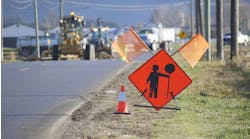As the COVID-19 pandemic continues to have lasting impacts, workforce and materials shortages are hitting businesses across the nation hard—and the roadway safety industry is no exception. As the industry comes together to get through these challenging times, organizations like the American Traffic Safety Services Association (ATSSA) are raising awareness and offering support.
ATSSA director of innovation and technical services Eric Perry said the organization was first made aware of the materials shortages early in 2021 by its High Friction Surface Treatment Council. The group reached out to ask ATSSA for support in notifying departments of transportation (DOT) about the shortages of high friction surface treatment products. “That got us thinking, what other materials could be plagued by this?” Perry said. The answer? Just about all of them.
After more investigation and outreach, ATSSA found that supply chains all across the industry were increasingly becoming disrupted. Impacted materials included metals like aluminum and steel, lumber, resins, plastic, and more. These materials are used in a wide variety of roadway safety products, from pavement markings to signage to traffic control devices.
On top of the production issues posed by COVID-19, Perry noted these shortages have been exacerbated by weather events like Hurricane Ida and the deep freeze Texas experienced this year.
In June, an ATSSA member survey found that 88 percent of respondents were experiencing some sort of raw materials shortage, an increase from 75 percent in its March survey. Following these surveys, ATSSA has continued to engage its members and the industry to help educate DOTs, local agencies and others about the current challenges. ATSSA president and CEO Stacy Tetschner sent a letter this month to the directors of every state DOT to update them on the ongoing challenges. In particular, he highlighted severe shortages of oxygen, which are needed to make glass beads for pavement marking applications.
The materials shortages aren’t the only challenge. Like many other industries, roadway safety is also struggling with a lack of workers. According to the U.S. Chamber of Commerce’s “The America Works Report: Quantifying the Nation’s Workforce Crisis,” there were 8.1 million job openings in March. That was up 600,000 vacancies from the previous month and set a record high. The Chamber report also stated that there are about half as many workers available for every job opening as there have been on average over the past 20 years—and the numbers aren’t improving.
Surveys of the roadway safety industry tell the same story. The 2021 Associated General Contractors of America survey shows at least 89 percent of contractors are having challenges finding workers. Approximately 54 percent of the contractors say they are having trouble hiring Safety Personnel (salaried positions); 77 percent are having trouble hiring Traffic Control Personnel (hourly positions); and 83 percent are having trouble hiring Laborers (hourly positions).
Karen Bobo, Director of the Federal Highway Administration’s Center for Transportation Workforce Development said these workforce challenges can be attributed to a few main issues: a lack of skilled workers, a lack of education and awareness among students and the public about careers in highway construction, potential employees’ desires for more flexible and family-friendly work schedules and potential employees’ lack of ability to pass drug tests. There is also the challenge of competing with other industries looking to fill their workforce as an aging population becomes eligible for retirement.
“The need to educate this country’s future on potential careers in transportation, highway construction, and roadway safety is imperative. This is needed to start bridging the gap and address the impact of an aging population,” Bobo said.
ATSSA is helping to combat these workforce challenges in part by working to attract younger people to the industry. Vice president of engagement Nathan Smith said trade schools and construction work are often overlooked by teachers and guidance counselors, leading to a lack of awareness around the viable career paths the roadway safety industry offers.
To help expose more young people to industry careers, ATSSA recently created a new student membership program that connects students or recent graduates with industry professionals. ATSSA has also partnered with the Transportation Research Board on its Traffic Control Device Challenge, where students develop innovative traffic control devices. Finalists get to present their projects at ATSSA’s annual convention.
Ultimately Smith said there’s no silver bullet for the workforce shortages across the industry, which he sees as an evergreen issue. In the short-term, he noted that the influx of federal and state funding from Congressional action on infrastructure will come alongside the challenge of a lack of workers to complete new projects. This difficult landscape motivates organizations like ATSSA to work even harder to attract talent to the industry and find a way forward.
“We need to be gearing up and we are gearing up, but we need to find a path forward to attract those workers because work is going to be there,” Smith said. “We have to be proactive and showcase that this is an attractive industry to be working in.”
Along with connecting with associations like ATSSA for support and guidance through difficult times, Smith said industry members can share their stories with their elected representatives to make an impact.
“They need to hear these stories of what the safety industry is experiencing right now from both a workforce shortage and a material shortage to understand that it's not a fallacy; it's reality right now,” Smith said. “That would really go a long way in trying to get elected officials to push forward policies that would alleviate some of these pressures.”
To learn more about the work ATSSA is doing to represent the roadway safety industry visit ATSSA.com.



